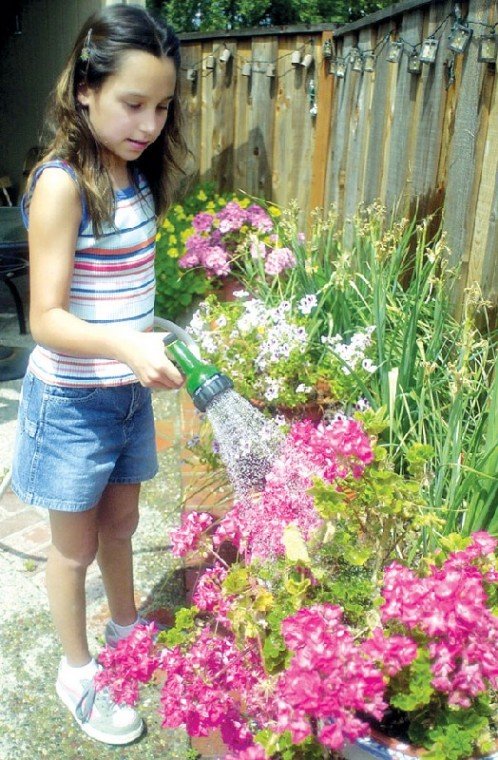At age 10, Ashley Ritters is well on the way to learning how to
manage her money.
The fourth grader who attends Jackson Elementary School in
Morgan Hill puts money from her weekly allowance
– as well as birthday and Christmas cash – in a savings account
her mother set up for her at a local Bank of the West branch.
At age 10, Ashley Ritters is well on the way to learning how to manage her money.
The fourth grader who attends Jackson Elementary School in Morgan Hill puts money from her weekly allowance – as well as birthday and Christmas cash – in a savings account her mother set up for her at a local Bank of the West branch.
“I feel good that my money is in a place where someone can’t take it,”Ashley says. “I’m actually trying to save my money for college.”
Her mom saw the need to teach Ashley the value of money about two years ago.
“Every time we’d go shopping or to the store, she would ask me to buy things,” Janet Itterly, her mother, said. “And I thought it was time she learned the value of a dollar.”
The two set up a financial system in which Ashley does various chores during the week and Itterly pays her an allowance based on job performance. Each week, Ashley makes between $8 and $10 from her household duties such as watering plants and feeding her pets.
“The tough part was trying to decide the monetary value for the jobs,” Itterly said.
Over time, they worked out a system in which Ashley keeps track of her chores by filling out a chart on a whiteboard.
The system isn’t just teaching Ashley skills in spending and saving money. She’s also developing responsibility and discipline too, Itterly said.
Recently, Ashley went on a shopping trip with her grandmother to Morgan Hill’s Mervyn’s store. She spent $32.89 of her allowance money on shorts and a tank top and feels proud she bought the clothes with money she earned herself. She also bought a school supply box for $1, but regrets the purchase because she doesn’t think she’ll use it.
“I felt like I spent too much money on it, and I should have saved the money to buy something more practical,” Ashley explained.
Money-management requires making choices, Ashley is learning. On trips to the supermarket, her mom often encourages her to make decisions between similar products based on their purchase value.
And Itterly also teaches Ashley about budgeting money for monthly household expenses such as the electric and telephone bills.
“We talk about the lights in the house and PG&E,” she says. “She’s learning to help reduce the energy costs.”
Ashley is also learning about how money affects relationships. She made a decision not to loan her school chums money if they ask. She doesn’t want such financial deals possibly ruining her friendships.
“I just don’t like to loan my money,” she said firmly. “I would say ‘no’ even if they ask me…. It’s kind of rude anyway.”
For kids like Ashley, learning how to manage money is an important step toward their future happiness, says Barmka Koroman, senior customer service officer at Gilroy’s South Valley National Bank. Many adults never learned how to spend and save
money wisely, and are now dealing with the stress of financial burdens such as credit card debt, she said.
And it’s never to early to start by opening up a savings account for a child, she said.
“There’s no real age requirement,” Koroman said. “The parents can open an account as soon as the child is born.”
The usual sum to open an account for a child is $50, but sometimes South Valley National Bank will start the child with a zero balance so long as the parents have some kind of automatic transfer, she said.
And she encourages parents to bring their kids to the bank and show them how to do banking chores such as filling in deposit slips.
“It makes a big difference,” she said about starting kids off early in responsible money management. “Once they get involved they learn (financial) skills that last a lifetime.”
Kid’s Quiz
Questions parents can ask young
kids to discuss money:
Why do you think we need money?
If money didn’t exist, how hard do you think it would
be to get things like food and clothes?
What does mom and dad have to do in order to get money?
Why do different things have different prices? For example, why does a house cost a lot more than a candy bar?
What’s better, to spend money on things like candy all the time, or to save it up and buy something you really want, like a nice toy?
Where can you put your money so you know it will be safe?
Tips on teaching kids about saving
Allowance Advice:
• Estimate what you pay each week on “gimme” purchases. Then make this your child’s weekly allowance.
• Talk to your children about what they are expected to pay for with the allowance.
• Have children keep a journal of how much money they have and how much they spend.
• Open a savings account where your children can regularly deposit allowance money. Encourage savings of 10 to 20 percent to buy high-ticket items.
• Try not to tie allowance money to chores, which should be a contribution to the family.
• Don’t tie money to homework. Schoolwork should be completed without any expectation of financial reward.
• Don’t punish your children by holding back the allowance.
• Pay on a timely schedule.
• Don’t give children extra money just because they are “good” or received good grades in school.
• Write down the rules of the allowance, clearly describing the exact sum of money each child receives and what the payment schedule is.
• Help your children develop a spending plan for the allowance, but don’t dictate what the money must be spent on.
• Don’t connect money and love by telling your children you’re giving them allowance money because you love them.
• Encourage children to donate a portion of the allowance to a charity or a good cause.
• Let your children make their own mistakes in spending money. The lessons learned early will help them greatly when they become adults and financial mistakes are much more costly.
Source: www.kidsmoney.org














